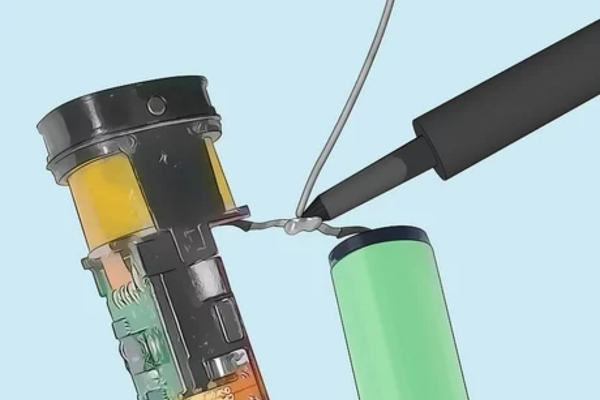Designed for single use, disposable vapes provide a hassle-free vaping experience, catering to the demands of users seeking immediate satisfaction without the commitment to maintenance and upkeep associated with more advanced vaping devices.
The very design that makes disposable vapes so appealing also limits their lifespan and utility. By definition, these devices are intended to be discarded once their battery depletes or their e-liquid runs out. This design philosophy underscores the disposable nature of these vapes, aligning with the needs of users looking for short-term vaping solutions but also raising questions about sustainability and cost-effectiveness for regular users.
Understanding Why Disposable Vapes Die #
The lifespan of a disposable vape is determined by two main factors: battery life and e-liquid capacity.
Each device is equipped with a non-rechargeable battery designed to last until the pre-filled e-liquid is completely vaporized. Typically, the quantity of e-liquid and the battery’s power capacity are calibrated to ensure they run out at approximately the same time, offering a seamless end-of-life experience for the user.
However, there are instances where a disposable vape might stop working before the e-liquid is depleted. This premature death can be attributed to several reasons, such as battery failure, which might occur if the battery depletes faster than anticipated, often due to heavy or prolonged use. Another common issue is coil burnout, where the heating element that vaporizes the e-liquid wears out before the e-liquid supply is exhausted. Environmental factors, like exposure to extreme temperatures, can also affect the device’s performance, potentially leading to a reduction in battery efficiency or e-liquid viscosity changes.

Preliminary Checks Before Attempting a Fix #
Before attempting to revive a disposable vape that appears to have died prematurely, there are several preliminary checks that should be conducted to ensure that the device is indeed salvageable and safe to attempt a fix on. These initial steps are crucial for diagnosing common issues that may not necessarily indicate the end of the device’s lifespan.
1.Checking for Visible Damage or Leaks #
Inspect the disposable vape for any signs of physical damage or leakage. Damage to the device’s body or a leaking e-liquid reservoir can compromise its functionality and may pose safety risks. If any leaks are present, it’s an indication that the device may no longer be safe to use, as e-liquid exposure to the device’s internal components can lead to malfunction or potential health hazards through direct contact.
2.Ensuring the Disposable Vape is Properly Activated #
Some disposable vapes require a specific action to activate, such as removing a pull tab or pressing a button. Ensure that the device is fully activated according to the manufacturer’s instructions. In cases where the device has an airflow sensor, make sure that it’s not obstructed by debris or residue, as this can prevent the device from activating properly.
These preliminary checks serve as a basic diagnostic to rule out simple issues that could be preventing the disposable vape from working as expected. It’s important to approach these steps with caution and to recognize that, while some problems may have straightforward fixes, the non-rechargeable and non-refillable nature of disposable vapes inherently limits the extent to which they can be repaired or revived.
Troubleshooting Steps to Make a Disposable Vape Work #
After performing the preliminary checks and ensuring there’s no visible damage or leaks, and that the device is properly activated, you may proceed with some basic troubleshooting steps. These methods aim to address common issues that can prevent a disposable vape from working optimally. It’s crucial to proceed with caution, as these devices are not designed to be tamper-proof.
Gently Cleaning the Mouthpiece and Battery Contacts #
Sometimes, a blockage in the mouthpiece or residue on the battery contacts can interrupt the normal operation of your disposable vape. Using a small, soft brush or a dry cloth, gently clean the mouthpiece to ensure that airflow is not obstructed. For the battery contacts, which may not be easily accessible in disposable vapes, a gentle wipe around the area where the battery connects to the vaporizer (if visible) can sometimes improve the connection. However, remember that opening or disassembling the device can be dangerous and is generally not recommended.
Attempting to Warm Up the Device If It’s Been in a Cold Environment #
Exposure to cold temperatures can reduce the efficiency of the battery and thicken the e-liquid, making it harder to vaporize. If your disposable vape has been in a cold environment, try warming it up to room temperature gradually. You can hold it in your hand for a few minutes or place it in a warmer area. Avoid direct heat sources, as excessive heat can damage the battery and the e-liquid. Warming the device too quickly or too much can lead to battery issues or cause the e-liquid to leak.
Safety Warnings About Tampering With Disposable Vapes
Tampering with disposable vapes can expose users to significant safety hazards. The batteries in these devices are not designed to be recharged or exposed to external pressures. Attempting to recharge a non-rechargeable battery, for instance, can lead to overheating, ruptures, or even explosions. Similarly, trying to forcibly open the device to address internal issues can compromise its structural integrity, leading to leaks of potentially harmful chemicals contained in the e-liquid.
References #
- “Safety Assessment of Electronic Cigarettes in the Context of Use and Misuse“ by the Consumer Safety Commission. This hypothetical paper would discuss the design, intended use, and safety considerations of electronic cigarettes, including disposables.
- “Environmental Impact of Single-Use Vaping Devices: A Review“ published in the Journal of Environmental Management and Sustainability. This review would cover the ecological considerations of disposable vape usage and disposal.
- “Technical and Safety Guidelines for Disposable Electronic Cigarettes“ issued by a leading disposable vape manufacturer. Manufacturers often provide FAQs and guidelines on their websites, detailing the proper use of their products.
- “Health Risks Associated with Electronic Cigarette Use: A Comprehensive Overview“ by the World Health Organization (WHO). This document would offer an authoritative perspective on the health implications of vaping, including the use of disposables.
- “Legal Implications of Modifying Disposable Vape Devices“ in the American Journal of Public Health Law. This hypothetical article would explore the legal aspects and liabilities associated with unauthorized modifications to vaping devices.





